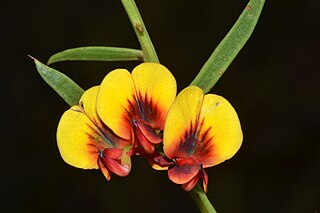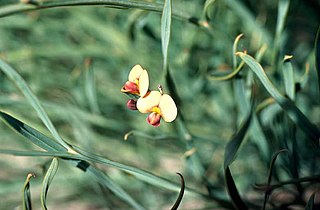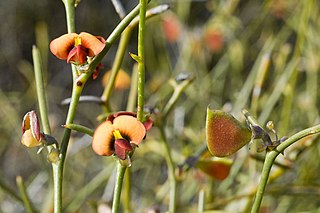
Daviesia, commonly known as bitter-peas, is a genus of about 130 species of flowering plants in the family Fabaceae, and is endemic to Australia. Plants in the genus Daviesia are shrubs or small trees with leaves modified as phyllodes or reduced to scales. The flowers are arranged singly or in groups, usually in leaf axils, the sepals joined at the base with five teeth, the petals usually yellowish with reddish markings and the fruit a pod.

Daviesia divaricata, commonly known as marno, is a species of flowering plant in the family Fabaceae and is endemic to the south-west of Western Australia. It is a low, spreading or erect and bushy shrub with phyllodes reduced to small, triangular scales, and orange and maroon flowers.

Daviesia hakeoides is a species of flowering plant in the family Fabaceae and is endemic to the south-west of Western Australia. It is a shrub with many tangled stems, scattered sharply-pointed phyllodes and yellow or orange and dark red flowers.

Daviesia angulata is a species of flowering plant in the family Fabaceae and is endemic to the south-west of Western Australia. It is an erect, spreading shrub with prickly, flattened phyllodes, and yellow flowers with red markings.

Daviesia bursarioides, commonly known as Three Springs Daviesia, is a species of flowering plant in the family Fabaceae and is endemic to a restricted part of the south-west of Western Australia. It is a straggling shrub with widely-spreading, spiny branches, scattered, flattened phyllodes, and yellow, deep pink and maroon flowers.

Daviesia cunderdin, commonly known as Cunderdin daviesia, is a species of flowering plant in the family Fabaceae and is endemic to a restricted area in the south-west of Western Australia. It is a compact, densely-branched shrub with scattered, elliptic to egg-shaped phyllodes, and uniformly red flowers.

Daviesia debilior is a species of flowering plant in the family Fabaceae and is endemic to the south-west of Western Australia. It is a shrub with low-lying stems and many erect branchlets, scattered linear to scale-like phyllodes, and yellow, purplish, orange-pink and dark purplish flowers.

Daviesia decurrens, commonly known as prickly bitter-pea, is a species of flowering plant in the family Fabaceae and is endemic to the south-west of Western Australia. It is spreading, erect, or low-lying shrub with scattered, sharply-pointed, narrow triangular phyllodes, and yellowish pink and velvety red flowers.

Daviesia aphylla is a species of flowering plant in the family Fabaceae and is endemic to the south-west of Western Australia. It is an erect, bushy shrub with glabrous foliage, up to six sharply-pointed phyllodes on each branchlet, and orange-red and yellow flowers.

Daviesia elongata is a species of flowering plant in the family Fabaceae and is endemic to the south-west of Western Australia. It is a glabrous, spreading or sprawling shrub with narrowly egg-shaped to linear phyllodes and yellow-orange and maroon flowers.

Daviesia euphorbioides, commonly known as Wongan cactus, is a species of flowering plant in the family Fabaceae and is endemic to a restricted area in the south-west of Western Australia. It is an open, erect to sprawling, cactus-like shrub with thick, fleshy branchlets and phyllodes reduced to scattered, sharply-pointed spines, and bright yellow, reddish-brown and maroon flowers.

Daviesia flexuosa is a species of flowering plant in the family Fabaceae and is endemic to the south-west coast of Western Australia. It is a glabrous, spreading shrub with zig-zagged branchlets, scattered, sharply-pointed, narrowly triangular phyllodes and yellow and red flowers.

Daviesia implexa is a species of flowering plant in the family Fabaceae and is endemic to the south-west of Western Australia. It is a mound-shaped shrub with many tangled stems, scattered linear phyllodes and yellow or apricot-coloured, reddish-brown and yellowish-green flowers.

Daviesia incrassata is a species of flowering plant in the family Fabaceae and is endemic to the south-west of Western Australia. It is an erect, mounded to spreading shrub with more or less zigzag branchlets, scattered needle-shaped phyllodes and orange, deep red and pink flowers.

Daviesia intricata is a species of flowering plant in the family Fabaceae and is endemic to the south-west of Western Australia. It is a glabrous shrub with densely tangled branches, sharply-pointed, needle-shaped or flattened phyllodes and apricot-yellow and dark red flowers.

Daviesia longifolia is a species of flowering plant in the family Fabaceae and is endemic to the south-west of Western Australia. It is an erect, many-stemmed shrub with scattered, erect, cylindrical phyllodes and yellow and red flowers.

Daviesia major is a species of flowering plant in the family Fabaceae and is endemic to the south-west of Western Australia. It is an erect, many-stemmed shrub with scattered, erect, sharply-pointed, cylindrical phyllodes and orange and red flowers.

Daviesia megacalyx is a species of flowering plant in the family Fabaceae and is endemic to a restricted part of the south-west of Western Australia. It is an erect, glabrous shrub with scattered, leathery, elliptic phyllodes and apricot-coloured and deep pink flowers.
Daviesia microcarpa, commonly known as Norseman pea, is a species of flowering plant in the family Fabaceae and is endemic to two small areas of inland Western Australia. It is a sprawling shrub with tangled stems and crowded, needle-shaped, sharply-pointed phyllodes, and orange and pinkish-red flowers.

Daviesia microphylla is a species of flowering plant in the family Fabaceae and is endemic to the south-west of Western Australia. It is an openly-branched, sprawling shrub with spiny branchlets, crowded, sharply-pointed, egg-shaped phyllodes, and orange, dark red and maroon flowers.



















